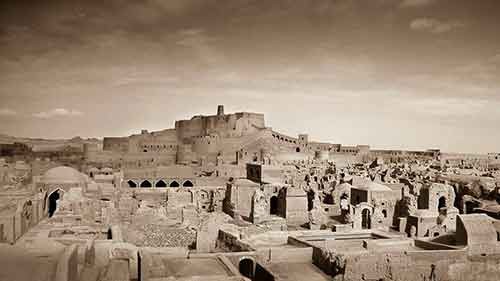
The ancient city of Bam, Iran, captured and published in a new book by Judi Iranyi. Photo by Judi Iranyi.
May 22, 2015
Judi Iranyi recently published a book of her photographs of Arg-e-Bam (Bam) from her November 2002 trip to Iran.
The ruined, historic city of Bam is located in southeastern Iran. It is made entirely of mud bricks, clay, straw, and the trunks of palm trees. The city was originally founded during the Sassanian period (224-637) and while some of the surviving structures date from before the 12th century, most of what remains today dates to the Safavid period (1502-1722). During Safavid times, the city occupied six square kilometers, was surrounded by a rampart with 38 towers, and had between 9,000 and 13,000 inhabitants.
Bam was a commercial and agricultural center on the famous Silk Road. It was also a stopping off place for pilgrims visiting its Zoroastrian fire temple.
Bam declined in importance following an Afghan invasion in 1722 and another invasion in 1810. The city was used as a barracks for the army until 1932 and then completely abandoned.
Intensive restoration work began in 1953 and continued until December 26, 2003 when the city of Bam was devastated by a 6.6 magnitude earthquake. The earthquake killed more than 26,000 people and resulted in the near total destruction of the restored ruins.
Ms. Iranyi’s book includes poetry by Persian lyric poet Hafez (1310-1390), translated from Farsi into English by Reza Ordoubadian.
Hafez was born in Shiraz, Iran. Very little is known about his life, but it is thought that he may have memorized the Qur’an after hearing his father recite passages. When his father died, he left school to work at a bakery and as a copyist. Hafez became a poet at the court of Abu Ishak and also taught at a religious college. He is one of the most celebrated of the Persian poets, and his influence can be felt to this day. As the author of numerous ghazals (a poetic form consisting of rhyming couplets and a refrain, with each line sharing the same meter) expressing love, spirituality and protest.
His collected works are regarded as a pinnacle of Persian literature and are to be found in the homes of most Iranians, who learn his poems by heart and use them as proverbs and sayings to this day.
Now a little about Judi Iranyi: She was born in Hungary during World War II. Later she emigrated with her parents and brother to Venezuela. She has also lived in Trinidad, Barbados and West Germany before moving to San Francisco in 1971 with her husband and son.
Ms. Iranyi became interested in photography in the 1960s. She studied photography and art at City College of San Francisco, San Francisco State University and U.C. Berkeley. She worked as a Licensed Clinical Social Worker until her retirement. Now that she is retired, Ms. Iranyi is dedicating her time to her photography.
To learn more about Ms. Iranyi and to view more of her photographs, please visit her website.


 The Hunger Site
The Hunger Site
May 23, 2015 at 5:36 am
expressing love, spirituality and protest. anonymous
quotes about life